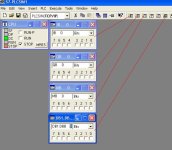Tim J
Member
I am taking a crash course (sink or swim) on Siemens Step 7 software. I don’t have a PLC to work with, so I am using the PLC simulator. We are working with two different processors, a CPU 319-3 PN/DP, and a CPU 315F-2 PN/DP. Most of the programs are already written, so my job is to translate the STL to ladder. I have so many questions, I’ll just start with a question or two.
When on line with the simulator, I want to turn bits on and off. It appears you can only do this with inputs (I can’t find a way to manipulate internal bits). My problem here is that even the inputs seem to work sometimes. I can right click on the element, and I click Modify to 1 (or 0). Sometimes the contact will change state, most times it won’t. I can click Control at Contact from the Debug menu, and that doesn’t seem to have any effect. I can open the simulator PLC and click on insert, then click on Insert Input Variable, set the address, and check the inputs I want to go high or low, and this seems to work every time. Is this the only way to manipulate Input bits and can it be used to manipulate internal PLC bits like M bits or data block bits? And what about bits in the declaration section of a block itself that are used in the block, is there a way to turn these bits on and off?
I have many questions about STL, but this is a good start.
Thanx to anyone who can help!
When on line with the simulator, I want to turn bits on and off. It appears you can only do this with inputs (I can’t find a way to manipulate internal bits). My problem here is that even the inputs seem to work sometimes. I can right click on the element, and I click Modify to 1 (or 0). Sometimes the contact will change state, most times it won’t. I can click Control at Contact from the Debug menu, and that doesn’t seem to have any effect. I can open the simulator PLC and click on insert, then click on Insert Input Variable, set the address, and check the inputs I want to go high or low, and this seems to work every time. Is this the only way to manipulate Input bits and can it be used to manipulate internal PLC bits like M bits or data block bits? And what about bits in the declaration section of a block itself that are used in the block, is there a way to turn these bits on and off?
I have many questions about STL, but this is a good start.
Thanx to anyone who can help!






